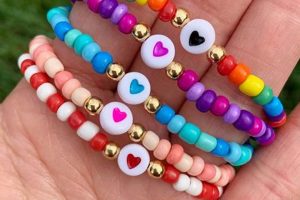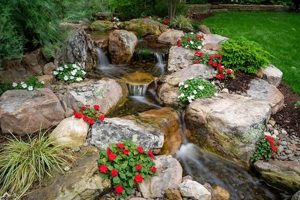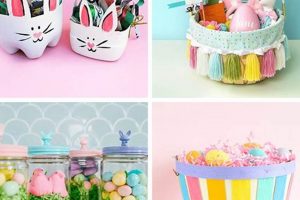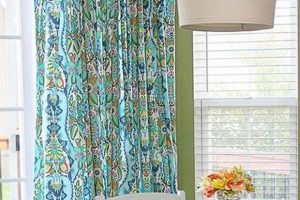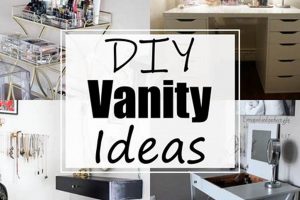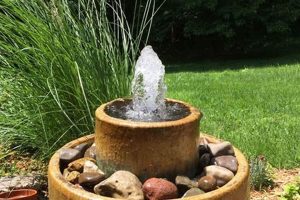Creating a customized aquatic environment involves constructing tanks and aquascapes from readily available materials. This encompasses a range of projects, from small desktop setups to larger, elaborate displays, often utilizing repurposed containers, custom-built stands, and self-sourced decor. For example, individuals may convert glass jars into nano-aquariums or construct multi-tiered rock structures using slate and aquarium-safe adhesives.
Engaging in self-sufficient aquarium creation offers several advantages. It provides a cost-effective alternative to purchasing pre-made aquariums and decorations. Furthermore, it fosters creativity and allows for the creation of unique environments tailored to specific aquatic species. Historically, constructing bespoke fish tanks was a necessity before the mass production of aquarium products, demonstrating an enduring interest in personalized aquatic design.
The subsequent sections will delve into practical aspects such as material selection, construction techniques, filtration strategies, and considerations for maintaining a stable and healthy ecosystem within a self-made aquarium.
Construction and Maintenance Considerations
Successfully establishing a self-made aquatic habitat requires adherence to best practices throughout the construction and operational phases.
Tip 1: Material Compatibility: Prioritize the use of inert materials. Glass, acrylic, and certain plastics designated as food-safe or aquarium-safe minimize the risk of leaching harmful chemicals into the water. Avoid materials containing heavy metals or volatile organic compounds.
Tip 2: Structural Integrity: Ensure adequate thickness of glass or acrylic based on the tank’s dimensions. Consult online resources and aquarium construction guides to determine appropriate material thicknesses and bracing requirements to withstand water pressure.
Tip 3: Sealing Techniques: Employ aquarium-grade silicone sealant for joining glass panels. Adhere strictly to the manufacturer’s instructions regarding curing time and application techniques to achieve a watertight seal. Perform a water test in a controlled environment prior to introducing livestock.
Tip 4: Filtration and Circulation: Implement a robust filtration system to remove particulate matter and maintain water quality. Consider the biological load of the intended inhabitants when selecting a filter type. Ensure adequate water circulation to prevent stagnant areas and promote gas exchange.
Tip 5: Substrate Selection: Choose a substrate appropriate for the intended inhabitants. Inert gravel, sand, or specialized aquarium substrates are suitable options. Avoid using garden soil or other materials that may decompose and release harmful substances.
Tip 6: Lighting Considerations: Select lighting that meets the specific needs of the plants and animals housed within the aquarium. Provide a consistent photoperiod to regulate biological processes and prevent algae blooms.
Tip 7: Water Chemistry Management: Regularly test and adjust water parameters to maintain optimal conditions for the inhabitants. Monitor pH, ammonia, nitrite, and nitrate levels and implement corrective measures as needed.
Adhering to these guidelines promotes a stable and healthy aquatic environment, minimizing potential complications and maximizing the lifespan of the self-constructed ecosystem.
The following section will address advanced concepts in customized aquatic environment design.
1. Cost-effective construction
Cost-effective construction is a central tenet of engaging in do-it-yourself aquarium creation. The motivation often stems from the desire to achieve a customized aquatic environment while mitigating the financial burden associated with commercially manufactured tanks and equipment. The correlation is direct: the degree to which a project employs resourceful material sourcing, efficient design, and repurposed components directly impacts the overall expenditure. For example, utilizing reclaimed glass panels for tank construction, sourcing rocks and driftwood from natural environments (after proper sterilization), and employing DIY filtration systems significantly reduce costs compared to purchasing equivalent items at retail prices. This economic incentive drives many hobbyists towards crafting their own aquatic displays.
The advantages of this approach extend beyond mere financial savings. It encourages innovation and a deeper understanding of the underlying principles of aquarium design and maintenance. Individuals are compelled to research alternative materials, experiment with different construction techniques, and devise creative solutions to common challenges. For instance, a DIY sump filtration system constructed from a repurposed plastic container can often provide superior filtration capacity at a fraction of the cost of a commercially produced unit. Furthermore, the cost savings can be reinvested into other aspects of the aquarium, such as higher-quality lighting or more diverse livestock.
However, the pursuit of cost-effectiveness must be balanced with safety and long-term stability. Compromising structural integrity or employing unsuitable materials can result in catastrophic failures, leading to property damage and potential harm to aquatic life. A successful cost-effective DIY aquarium requires a thorough understanding of material properties, engineering principles, and the biological requirements of the intended inhabitants. The long-term benefits of reduced initial costs are negated if the aquarium is prone to leaks, requires frequent repairs, or fails to provide a suitable environment for aquatic life.
2. Customization possibilities
The inherent appeal of self-made aquatic environments lies in the capacity for extensive customization. Unlike mass-produced aquariums constrained by standardized dimensions and designs, the do-it-yourself approach enables unparalleled adaptation to individual preferences, spatial limitations, and the specific needs of aquatic species.
- Bespoke Dimensions and Form Factors
Standard aquarium sizes often fail to integrate seamlessly into unique architectural spaces or accommodate specific aquascaping visions. DIY construction permits the creation of tanks with unconventional dimensions, such as corner tanks, long shallow tanks for riparian environments, or vertically oriented tanks for specific fish species. This flexibility ensures optimal integration into the designated environment and maximizes available space.
- Specialized Aquascaping and Substrate Design
Pre-fabricated aquariums often feature limited substrate depth and restricted access for aquascaping. DIY projects allow for the creation of intricate bottom contours, integrated rock structures, and tiered planting areas tailored to the requ
irements of specific plant species and the aesthetic preferences of the aquarist. Furthermore, custom substrate mixes can be formulated to optimize nutrient availability and root development. - Integrated Filtration and Plumbing Systems
Commercially available aquariums often utilize external filtration systems that may detract from the overall aesthetic or occupy valuable space. DIY construction facilitates the seamless integration of filtration and plumbing within the aquarium structure, concealing unsightly equipment and optimizing water flow dynamics. Custom sump systems, overflow boxes, and closed-loop circulation systems can be designed to meet the specific needs of the aquatic ecosystem.
- Adaptive Lighting and Environmental Control
Standard aquarium lighting fixtures may not provide the optimal spectral output or intensity required for plant growth or coral coloration. DIY projects enable the integration of custom LED arrays, programmable lighting controllers, and automated environmental control systems to precisely regulate temperature, light, and other parameters, creating an environment tailored to the specific needs of the inhabitants.
The convergence of dimensional freedom, specialized aquascaping potential, integrated systems, and adaptive environmental control mechanisms underscores the transformative potential of DIY aquarium design. This level of customization empowers aquarists to create truly unique and thriving aquatic ecosystems tailored to their specific vision and the needs of their aquatic inhabitants.
3. Material Suitability
Material suitability constitutes a cornerstone of successful self-constructed aquatic ecosystems. The selection of appropriate materials directly influences the structural integrity, chemical stability, and overall health of the aquarium environment. Deviations from established best practices can lead to catastrophic failures or chronic toxicity issues, jeopardizing the well-being of aquatic life.
- Inertness and Chemical Compatibility
The primary consideration revolves around the material’s inertness in an aquatic environment. Materials must resist degradation and leaching of harmful substances into the water column. Examples of suitable materials include aquarium-grade silicone sealant, glass, acrylic, and certain plastics designated as food-safe or aquarium-safe. Conversely, materials containing heavy metals (e.g., lead), volatile organic compounds (VOCs), or unstable polymers are demonstrably unsuitable due to their potential to contaminate the water and negatively impact aquatic organisms.
- Structural Integrity and Load-Bearing Capacity
The selected materials must possess sufficient structural integrity to withstand the hydrostatic pressure exerted by the water. Glass and acrylic, commonly employed for tank construction, require careful consideration of thickness based on the tank’s dimensions and the intended water depth. Failure to adhere to established engineering principles can result in structural failure and catastrophic water leakage. Similarly, materials used for constructing stands or supports must possess adequate load-bearing capacity to safely support the weight of the filled aquarium.
- Durability and Resistance to Degradation
Aquatic environments present a harsh combination of constant moisture, fluctuating temperatures, and potential exposure to ultraviolet (UV) radiation. Materials employed in construction must exhibit durability and resistance to degradation under these conditions. Untreated wood, for example, is susceptible to rot and fungal growth, while certain metals are prone to corrosion. Selecting materials that are inherently resistant to these forms of degradation minimizes the risk of premature failure and prolongs the lifespan of the aquarium.
- Surface Properties and Biofilm Formation
The surface properties of materials influence the formation of biofilms, which play a crucial role in the nitrogen cycle and the overall health of the aquarium ecosystem. Materials with smooth, non-porous surfaces are generally easier to clean and maintain, reducing the accumulation of detritus and algae. Conversely, highly porous materials may provide increased surface area for beneficial bacteria colonization but can also harbor anaerobic bacteria and contribute to water quality problems.
The interplay of inertness, structural integrity, durability, and surface properties underscores the critical importance of material suitability in the context of self-constructed aquatic displays. Informed material selection, grounded in a thorough understanding of chemical compatibility, engineering principles, and biological considerations, is paramount for the creation of a stable, healthy, and aesthetically pleasing aquarium environment.
4. Filtration efficiency
Filtration efficiency represents a critical parameter within self-constructed aquatic ecosystems. Its optimization is inextricably linked to the long-term health, stability, and aesthetic appeal of any do-it-yourself aquarium project. Implementing an inadequate filtration system directly compromises water quality, leading to elevated levels of harmful compounds and increased susceptibility to disease outbreaks.
- Mechanical Filtration and Particulate Removal
Mechanical filtration focuses on the removal of suspended particulate matter from the water column. DIY aquarium designs often incorporate mechanical filtration through the use of sponge filters, filter floss, or settling chambers. The efficiency of mechanical filtration directly impacts water clarity and reduces the biological load on subsequent filtration stages. For instance, a well-designed pre-filter composed of multiple layers of filter foam effectively traps debris, preventing it from clogging biological filter media and reducing the overall maintenance frequency.
- Biological Filtration and Nitrogen Cycle Management
Biological filtration relies on the establishment of beneficial bacteria colonies that convert harmful ammonia and nitrite into less toxic nitrate. In DIY aquariums, biological filtration is commonly achieved through the use of media such as ceramic rings, lava rock, or bio-balls. Filtration efficiency is determined by the surface area available for bacterial colonization and the flow rate of water through the filter media. Optimizing biological filtration is paramount for maintaining a stable nitrogen cycle and preventing the accumulation of toxic ammonia and nitrite, which are lethal to aquatic life.
- Chemical Filtration and Water Chemistry Control
Chemical filtration involves the use of specialized media to remove specific pollutants or adjust water chemistry parameters. Activated carbon, for example, effectively removes organic compounds and medications from the water column, improving clarity and reducing odors. DIY aquarium projects can incorporate chemical filtration through the use of media bags or dedicated chemical filtration chambers. The efficiency of chemical filtration depends on the type of media used and its contact time with the water. Regular replacement of chemical filtration media is necessary to maintain its effectiveness.
- Flow Rate and Water Circulation
Adequate flow rate and water
circulation are essential for maximizing filtration efficiency. Insufficient flow can lead to dead spots within the aquarium where detritus accumulates and anaerobic bacteria thrive. DIY aquarium designs should incorporate pumps or powerheads to generate sufficient water movement and ensure that all areas of the tank receive adequate filtration. The appropriate flow rate depends on the size and shape of the aquarium, as well as the biological load and the specific needs of the inhabitants. Optimizing flow rate improves water quality and promotes gas exchange, contributing to a healthier and more stable aquatic environment.
The synergistic interaction of mechanical, biological, and chemical filtration, coupled with optimized flow rate, determines the overall filtration efficiency of a do-it-yourself aquarium system. Diligent attention to these facets ensures a stable and healthy aquatic environment, reducing the risk of disease outbreaks and promoting the well-being of the inhabitants.
5. Ecosystem stability
Ecosystem stability, in the context of self-constructed aquatic environments, refers to the capacity of the system to resist or recover from disturbances while maintaining essential functions and biodiversity. The inherent complexity of a closed aquatic system necessitates meticulous planning and execution in DIY aquarium projects to achieve a semblance of natural equilibrium. Improper material selection, inadequate filtration, or inappropriate stocking densities can disrupt delicate biological processes, leading to cascading effects that destabilize the entire ecosystem. For instance, using unwashed gravel as a substrate may introduce excessive organic matter, causing an ammonia spike that jeopardizes fish and invertebrate populations. Similarly, overstocking an aquarium without sufficient biological filtration capacity results in elevated nitrate levels, fostering algae blooms and hindering plant growth. The achievement of ecosystem stability directly correlates with the aquarist’s understanding and application of fundamental ecological principles.
The practical significance of understanding this connection lies in the ability to proactively mitigate potential problems. A well-planned DIY aquarium incorporates redundant systems and safeguards to buffer against unforeseen events. Employing an oversized filter, implementing a refugium to promote beneficial microbial activity, and maintaining a consistent water change schedule collectively contribute to a more resilient system. Furthermore, careful observation and regular water testing enable early detection of imbalances, allowing for timely corrective actions. An example would be the immediate reduction in feeding rates upon detection of elevated ammonia levels, thereby reducing the bioload and preventing a potential crisis. The aquarist, in effect, becomes an active participant in maintaining the health and stability of the artificial ecosystem.
In summary, the successful integration of “Ecosystem stability” within “diy aquarium ideas” requires a holistic approach that encompasses careful planning, informed material selection, diligent maintenance, and a proactive approach to problem-solving. While challenges inherent in replicating natural ecosystems within a confined space persist, a thorough understanding of the underlying ecological principles empowers hobbyists to create thriving and self-sustaining aquatic environments.
6. Aesthetic integration
Aesthetic integration, within the sphere of self-made aquatic environments, represents the deliberate harmonization of the aquarium with its surrounding architectural and decorative context. Beyond its purely functional purpose, a properly integrated aquarium functions as a dynamic art piece, enhancing the visual appeal of its setting. Its implementation necessitates a comprehensive understanding of design principles and a careful consideration of spatial relationships.
- Dimensional Harmony and Spatial Proportions
The physical dimensions of the aquarium must complement the scale of the room and the furniture within it. An oversized tank can overwhelm a small space, while an undersized tank may appear insignificant in a large room. Considerations must extend to the tank’s height, width, and depth, ensuring that these proportions are aesthetically pleasing and do not create visual imbalance. The placement of the aquarium within the room is also critical, as it should not obstruct pathways or detract from other focal points.
- Material Palettes and Color Coordination
The materials used in the construction of the aquarium stand, canopy, and surrounding decor should harmonize with the existing color scheme and architectural style of the room. Matching the wood finishes, metal accents, and fabric textures creates a cohesive visual narrative. The colors within the aquarium itself, including the substrate, rocks, and plants, should also be carefully selected to complement the overall aesthetic. Avoiding clashing colors and excessive visual clutter enhances the sense of tranquility and visual appeal.
- Lighting Integration and Ambient Illumination
The aquarium lighting should not only provide optimal conditions for aquatic life but also contribute to the ambient illumination of the room. Choosing lighting fixtures that emit a warm or cool tone can dramatically alter the perceived atmosphere. The intensity of the lighting should be adjusted to prevent glare or excessive brightness, ensuring a comfortable viewing experience. The integration of dimming controls allows for fine-tuning the lighting to match the time of day and create a more naturalistic effect.
- Aquascaping Style and Thematic Consistency
The aquascaping style should align with the overall design aesthetic of the room. A minimalist room might benefit from a sparsely planted aquarium with clean lines and a focus on negative space, while a more eclectic room could accommodate a densely planted aquarium with a more organic and naturalistic design. Maintaining thematic consistency between the aquarium and the surrounding decor creates a sense of visual harmony and reinforces the overall aesthetic vision.
The convergence of dimensional harmony, material palettes, lighting integration, and aquascaping style epitomizes the essence of aesthetic integration in the context of self-made aquatic environments. By meticulously addressing each of these facets, individuals can transform a simple aquarium into a captivating centerpiece that elevates the overall ambiance of the space and provides a visually stimulating and enriching experience.
7. Maintenance accessibility
Maintenance accessibility, in the context of DIY aquarium projects, significantly influences the long-term viability and success of these ecosystems. The ease with which one can perform routine maintenance tasks directly impacts the frequency and thoroughness of said tasks. When designing a self-made aquarium, accessibility considerations must be paramount, shaping design choices from tank construction to equipment placement. Inaccessible components invariably lead to neglected maintenance, resulting in water quality deg
radation, increased risk of disease outbreaks, and a shortened lifespan for aquatic inhabitants. A prime example is a poorly designed stand that restricts access to the sump, hindering filter cleaning and water changes, ultimately leading to a decline in water parameters and overall ecosystem health. Therefore, maintenance accessibility constitutes a critical, often overlooked, component of DIY aquarium creation, demanding meticulous planning from the outset.
Practical application involves incorporating design features that streamline maintenance procedures. This may include strategically placed access panels in the stand, allowing unobstructed access to filtration equipment. The use of quick-disconnect fittings in plumbing facilitates easy removal of pumps and other components for cleaning or repair. Employing modular aquascaping elements, like pre-assembled rock structures, enables effortless removal and cleaning of detritus accumulation beneath. Furthermore, designing the tank with sufficient open space above the water line simplifies tasks such as algae removal and water level adjustments. Consideration must also be given to the accessibility of electrical components, ensuring that they are safely and easily accessible for inspection and maintenance, minimizing the risk of electrical hazards during routine procedures. Failure to incorporate these considerations can transform routine maintenance into arduous and time-consuming endeavors, increasing the likelihood of neglect and compromising the health of the aquatic environment.
In summation, the connection between maintenance accessibility and DIY aquarium ideas is inextricable. Neglecting accessibility considerations during the design and construction phase directly translates to increased maintenance burden and a higher risk of ecosystem instability. While creative aquascaping and innovative designs are laudable, prioritizing ease of maintenance is essential for the long-term success and sustainability of any self-made aquarium project. The challenge lies in balancing aesthetic aspirations with practical considerations, ensuring that the final product is not only visually appealing but also functionally accessible and easy to maintain, thereby promoting a thriving and healthy aquatic environment.
Frequently Asked Questions Regarding DIY Aquarium Ideas
This section addresses common inquiries and concerns related to the construction and maintenance of self-made aquariums, providing clear and concise answers to frequently asked questions.
Question 1: What are the primary safety considerations when constructing a glass aquarium?
The selection of appropriate glass thickness based on tank dimensions is paramount to withstand water pressure. Tempered glass offers enhanced strength and shatter resistance compared to standard glass. The use of aquarium-grade silicone sealant is essential for creating a watertight and chemically inert bond. Proper ventilation should be ensured during the curing process of the sealant.
Question 2: Is it feasible to construct an aquarium stand from wood?
Wood is a viable option for aquarium stands, provided it is properly treated to resist moisture and decay. Pressure-treated lumber or wood sealed with a waterproof coating is recommended. The stand’s design must adequately distribute the weight of the filled aquarium. Consideration should be given to the stand’s ability to support the weight of the tank and any equipment, with an additional safety margin.
Question 3: How is adequate filtration achieved in a DIY aquarium setup?
Filtration can be achieved through various methods, including sponge filters, under-gravel filters, and sump systems. The selection depends on tank size, bioload, and the specific needs of the inhabitants. A combination of mechanical, biological, and chemical filtration is often employed to maintain optimal water quality. Regular maintenance of the filtration system is essential for its continued effectiveness.
Question 4: What are the recommended materials for aquarium substrate?
Substrate materials should be inert and non-toxic. Gravel, sand, and specialized aquarium substrates are suitable options. Avoid using garden soil or other materials that may decompose and release harmful substances into the water. The selection of substrate should align with the needs of the intended inhabitants, such as burrowing species or plants that require specific nutrients.
Question 5: Can repurposed containers be used for constructing small aquariums?
Repurposed containers, such as glass jars or plastic tubs, can be used for constructing small aquariums, provided they are food-safe or aquarium-safe and structurally sound. Thorough cleaning and disinfection are essential to remove any residual contaminants. The container must be able to withstand the weight of the water and any added decorations.
Question 6: How is a stable and healthy ecosystem maintained in a DIY aquarium?
Maintaining a stable ecosystem requires careful monitoring and adjustment of water parameters, including pH, ammonia, nitrite, and nitrate levels. Regular water changes, appropriate lighting, and proper feeding practices are essential. The introduction of beneficial bacteria and the maintenance of a balanced population of plants and animals contribute to overall ecosystem stability. Quarantining new additions to prevent the introduction of diseases is highly recommended.
Successful implementation of DIY aquarium projects hinges on a thorough understanding of safety protocols, material properties, filtration principles, and ecological balance. Adherence to best practices is paramount for creating a thriving and sustainable aquatic environment.
The subsequent section will explore advanced concepts in customized aquatic environment design, including innovative aquascaping techniques and automated control systems.
Conclusion
The preceding analysis explored various facets of DIY aquarium ideas, encompassing design, construction, maintenance, and long-term ecosystem stability. Emphasis was placed on the criticality of material selection, structural integrity, filtration efficiency, and the delicate balance required to sustain aquatic life within a closed environment. The information presented underscores that successful implementation necessitates more than just creative inclination; it demands a foundation of knowledge and meticulous attention to detail.
The creation of a self-made aquatic habitat represents a significant undertaking, demanding responsible consideration of the biological and environmental consequences. Prospective aquarists should diligently research best practices and prioritize the well-being of aquatic organisms. The long-term sustainability of any aquatic environment relies on informed decision-making and a commitment to continuous learning. Independent construction of aquatic ecosystems requires accepting the complete accountability for the health and safety of the tank’s inhabitants.


